The Intel Broadwell Desktop Review: Core i7-5775C and Core i5-5675C Tested (Part 1)
by Ian Cutress on June 2, 2015 7:45 AM ESTProfessional Performance: Windows
Agisoft Photoscan – 2D to 3D Image Manipulation: link
Agisoft Photoscan creates 3D models from 2D images, a process which is very computationally expensive. The algorithm is split into four distinct phases, and different phases of the model reconstruction require either fast memory, fast IPC, more cores, or even OpenCL compute devices to hand. Agisoft supplied us with a special version of the software to script the process, where we take 50 images of a stately home and convert it into a medium quality model. This benchmark typically takes around 15-20 minutes on a high end PC on the CPU alone, with GPUs reducing the time.
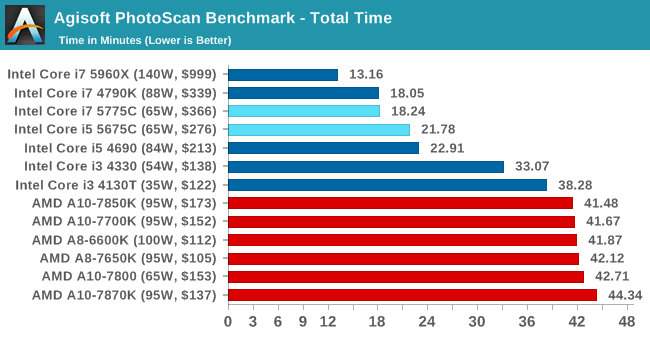
The presence of Crystal Well had a small effect on Photoscan, occurring mostly in the second phase of the calculation which is the one that also has an option to enable the GPU, indicating that memory bandwidth is an potential limitation in that segment.
Cinebench R15
Cinebench is a benchmark based around Cinema 4D, and is fairly well known among enthusiasts for stressing the CPU for a provided workload. Results are given as a score, where higher is better.
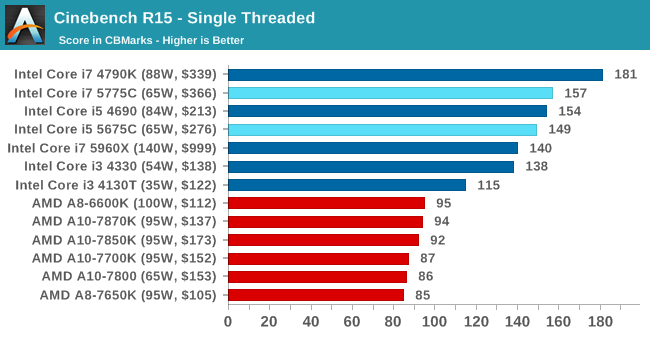
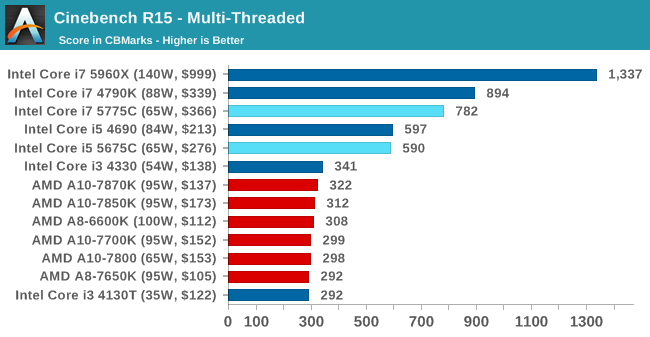
Cinebench is a historically CPU-limited benchmark, and the results show this again here. The fact that the 3.6GHz Broadwell-based i5-5675C performs so closely to the 3.9GHz Haswell-based i5-4690 is a promising sign here, as it means that despite being a mere "tick" in Intel's development efforts, there are tangible IPC increases on the desktop from Broadwell.
HandBrake v0.9.9: link
For HandBrake, we take two videos (a 2h20 640x266 DVD rip and a 10min double UHD 3840x4320 animation short) and convert them to x264 format in an MP4 container. Results are given in terms of the frames per second processed, and HandBrake uses as many threads as possible.
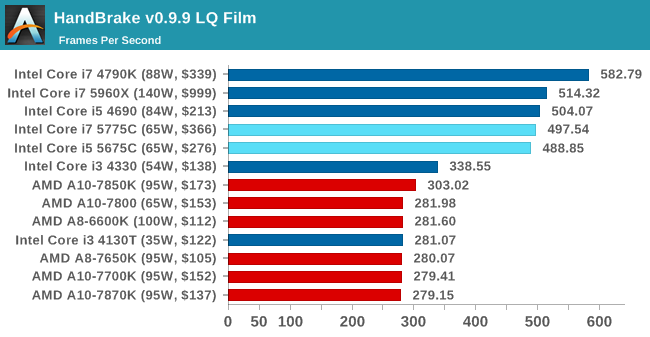

While no obvious improvement was seen in the low quality conversion, the double UHD conversion put the i7 above what was otherwise expected.
Hybrid x265
Hybrid is a new benchmark, where we take a 4K 1500 frame video and convert it into an x265 format without audio. Results are given in frames per second.
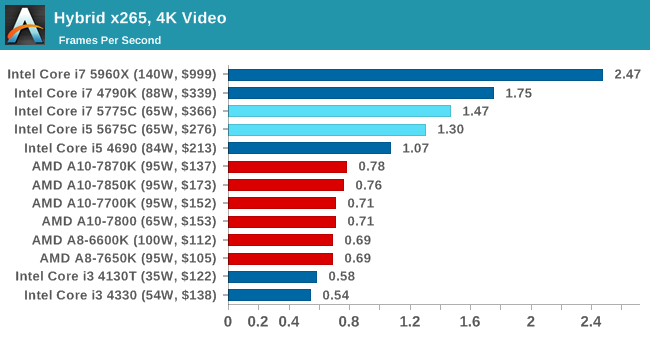
Unlike the Handbrake H.264 tests, the Hybrid x265 tests show a clear uptick in performance on the Broadwell processors. It is not fast enough to catch the i7-4790K and its 4.4GHz turbo clockspeed, but we see the i5-5675C shoot well past the i5-4690 despite the clockspeed deficit. Whether this is due to Broadwell architecture enhancements, Crystal Well acting as an L4 cache, or a combination of the two is difficult to determine, but the end result is substantial.










196 Comments
View All Comments
Oxford Guy - Wednesday, June 10, 2015 - link
"I know it's a dead socket, but could we AM3+ users request a CPU be thrown in the mix?"It might mess up the charts, which clearly make it look like you need to buy an Intel CPU rather than a $100 8320E with a motherboard discounted $40 (Microcenter).
Spectrophobic - Sunday, June 7, 2015 - link
I think an i7 with an Iris Pro 6200 is just a waste of die space, considering that you should be using a discrete card. An i5 should be fine, but an i3 w/ 6200 would be great at HTPC and light media scenarios.Doubt they're gonna release another Broadwell though. Hopefully i3 Skylake get the Iris Pro treatment.
PauloBrazil - Thursday, June 11, 2015 - link
is missing the tests with DirectX 12DirectX 11 is already exceeded
DirectX 11 uses more single core
Romulous - Thursday, June 11, 2015 - link
Some reviewerstwhile correctly call UHD .. well UHD. I thought a site like anandtech would get this correct. Stop calling it 4K!crashtech - Tuesday, June 16, 2015 - link
OK, time for part 2, please! :)varg14 - Wednesday, June 17, 2015 - link
When is part 2?Staafk - Wednesday, June 17, 2015 - link
Also waiting for part 2 now. Any eta on that? :-)Also I don't see why people don't want integrated graphics on high end cpus. I am under the impression that the integrated graphics is able to work with the discrete graphics card with dx12, adding some fps at least vs a cpu with no integrated graphics?
tuxRoller - Sunday, June 21, 2015 - link
You might want to give the phoronix test suite a look.It is very easy to use and provides many, many tests.AnnonymousCoward - Thursday, June 25, 2015 - link
I don't get it. Someone please explain why Intel doesn't make a non-iGPU version to cut their silicon cost in half for those who don't want it.edwardtoday - Monday, July 13, 2015 - link
In the 2nd page, the first word of the paragraph above the "Broadwell-K, or is it Broadwell-C, or Broadwell-H?" header, "Ultiamtely", should be "Ultimately".